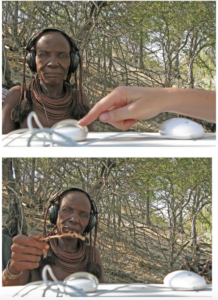Universal and culture-specific recognition of emotions
 Participant watching the experimenter play a stimulus
Participant watching the experimenter play a stimulus
and indicating her response
There is an intersting forthcoming open access (available here) article of PNAS entitled "Cross-cultural recognition of basic emotions through nonverbal emotional vocalizations," by Disa Sauter, Frank Eisner, Paul Ekman, and Sophie K. Scott. [1]
Abstract:
Emotional signals are crucial for sharing important information, with conspecifics, for example, to warn humans of danger. Humans use a range of different cues to communicate to others how they feel, including facial, vocal, and gestural signals. We examined the recognition of nonverbal emotional vocalizations, such as screams and laughs, across two dramatically different cultural groups. Western participants were compared to individuals from remote, culturally isolated Namibian villages. Vocalizations communicating the so-called "basic emotions" (anger, disgust, fear, joy, sadness, and surprise) were bidirectionally recognized. In contrast, a set of additional emotions was only recognized within, but not across, cultural boundaries. Our findings indicate that a number of primarily negative emotions have vocalizations that can be recognized across cultures, while most positive emotions are communicated with culture-specific signals.
[1] This article has been corrected. See correction here.


